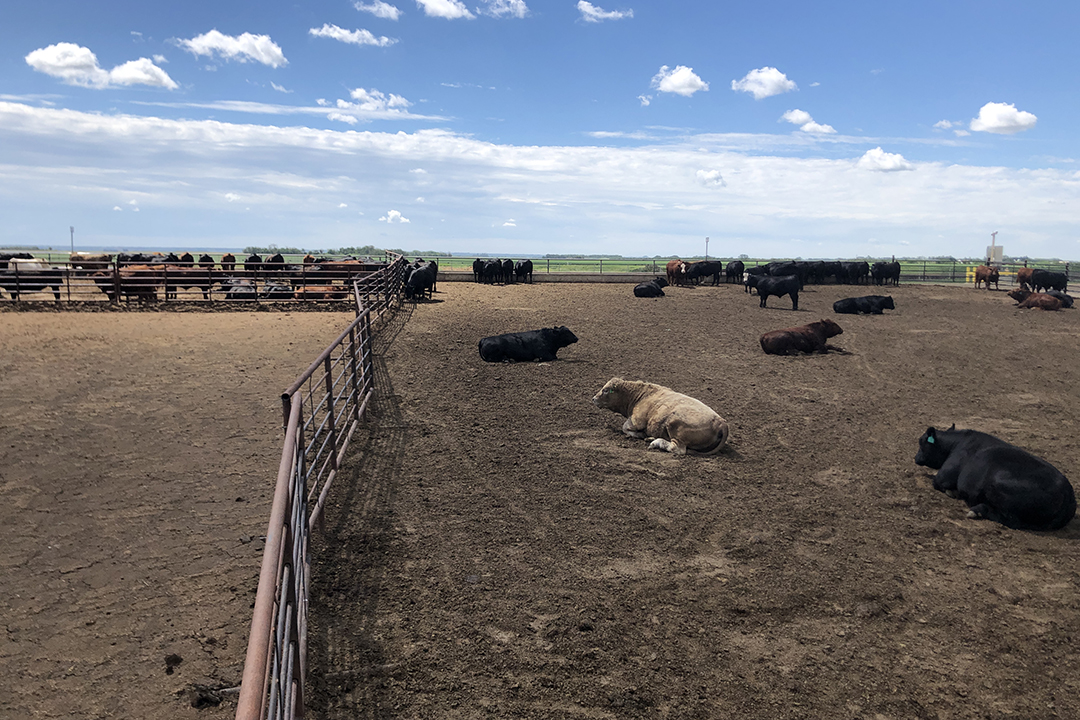
USask scientists study space and sickness in feedlot cattle
As researchers at the University of Saskatchewan (USask) and Western College of Veterinary Medicine (WCVM) study the impact of stocking density and feed bunk space allowance on the health of beef cattle, they’re pondering the age-old question: “Is less really more?”
By Avery Chora
Welfare and health of food production animals are active areas of concern for both producers and consumers. As animal rights lobbyists voice their concerns for the welfare of food production animals, researchers continue to focus on improving conditions for all animals.
That focus is the motivation for a research team that includes Dr. Diego Moya (DVM, PhD) from the WCVM along with researchers Dr. Greg Penner (PhD) and Kathy Larson from USask College of Agriculture and Bioresources.
They’re investigating whether the amount of space per animal in a feedlot setting causes additional stress and competition that affect an animal’s digestive processes and behaviour.
The researchers are particularly concerned about the prevalence of rumen acidosis and liver abscesses — health issues that continue to be one of the main concerns in feedlot cattle fed high grain diets.
“We were surprised when looking at the literature, there weren’t many studies assessing how both stocking density and feed bunk allowance could interfere with acidosis — and as a consequence, liver abscesses in feedlot cattle” says Moya, an assistant professor in the WCVM’s Department of Large Animal Clinical Sciences.
The USask researchers speculate that cattle consume feed faster when their access to space and their feed bunk allowance are restricted. As a result, their feed ferments differently, increasing their risk for developing rumen acidosis and consequently liver abscesses.
The standard industry pen allowance is 15 square metres per animal per pen and 30 centimetres per animal in feed bunks. Using that standard for their guide, Moya and his team modified both pen and feed bunk space in order to investigate whether the amount of space allotted per animal affects the incidence of these two common health concerns.
The project uses a total of 900 steers over three periods. In each period, 300 steers are housed in six pens, each one holding 50 head of cattle. Each pen is designed to test two factors: stocking density and feed bunk space.
Moya and his team use portable fences at the Livestock and Forage Centre of Excellence (LFCE) to change the amount of space in both pens and feed bunks. That allows them to test low, standard and high stocking densities as well as standard and high feed bunk space.
“We have large pens that replicate in a controlled environment what would be happening at a commercial setting,” Moya says. “The main goal is to provide science-based guidelines for the industry by seeing how we can optimize the use of pens to improve performance and welfare.”
In order to assess general health and detect any signs of systemic inflammation in the cattle from each of the six groups, the researchers measure levels of hair cortisol (a biomarker of stress) as well as blood haptoglobin, a protein that elevates in response to tissue damage and infections. They also monitor animal temperament, flight speed (the speed at which an animal leaves the chute) and behaviours at the pen.
“All these factors can contribute to a general idea of whether the animals are more agitated or spend more time in agonistic interactions, which should be prevented as much as possible,” explains Moya.
In addition to determining whether any of the groups experience additional stress, the study also investigates the effects of that stress and whether it lowers animal productivity and carcass quality.
The project, which received funding from the Beef Cattle Research Council (BCRC) and Saskatchewan’s Ministry of Agriculture, consists of three periods: the first one ran from April to August 2021, the second one was completed in 2022 and the third period will run in 2023.
“It will be a long-term trial lasting three years, but I’m happy to be a part of it and contribute to the industry,” says Moya.
Avery Chora of Oliver, B.C., is a third-year veterinary student at the WCVM who worked as a summer research student in 2021. Her story is part of a series of articles written by WCVM summer research students.
